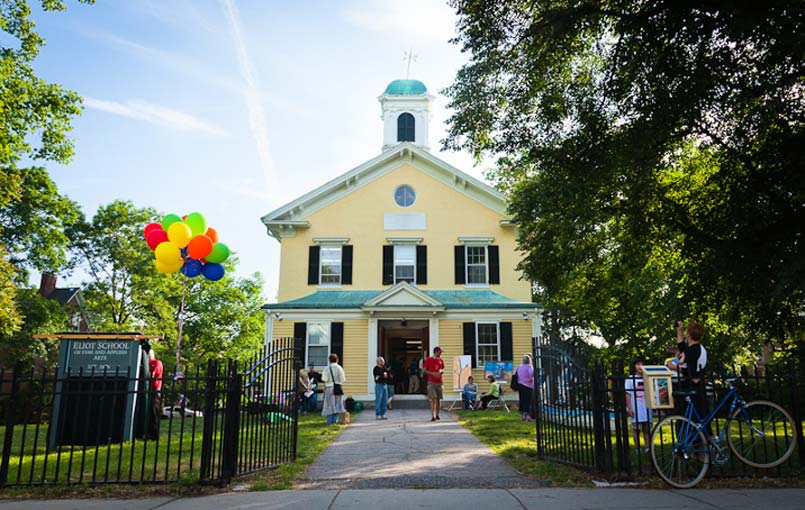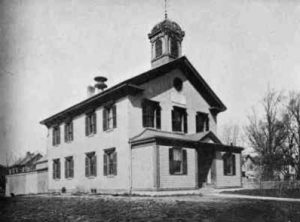
24 Feb 2017 The Eliot School of Fine & Applied Arts
Abigail Norman is the Director of the Eliot School in Jamaica Plain. In her first guest blog with HBI, Abigail traces the history of the Eliot School, which was founded in 1676 and recently celebrated its 340th anniversary.
Tucked between Jamaica Pond and JP’s business district is a charming 19th century schoolhouse, a yellow brick rectangle in the center of an open schoolyard ringed by a cast iron fence. The school carries on the same work it has done for some 140 years, building on over 200 years as a grammar school before that. Inside, children after school build toolboxes and toy sailboats out of wood, or sew aprons and stuffed animals. Adults built fine cabinetry and engage in fashion design, construct artists? books and experiment with assemblages and sculptural crochet.
The school just celebrated its 340th anniversary with a year of parties, talks and a traveling exhibition. It was founded in 1676, when neighbors contributed corn and land to start a school. Then in 1690, local minister John Eliot died, bequeathing 75 acres of land to fund a school “for Indians, Negroes and children from this end of town.”
The schoolhouse dates to 1831. Its 1892 embellishments include a copper-clad Victorian cupola and entryway.
In 1874, when that area joined the City of Boston, the Eliot School trustees endeavored to use the funds left from John Eliot?s legacy to step beyond the boundaries of the customary education of  the day. They turned the Eliot High School, on Elm Street, over to the public school system, and turned their attention, and their schoolhouse space, to manual arts. Leadership overlapped with faculty and founders of the new Massachusetts Institute of Technology. Robert Hallowell Richards, mineralogy professor, lived just a few doors from the school. A new trustee, he brought his passion for hands-on learning to the board. By the early 1890s, the school had fully made a transition away from academics. It developed curricula in mechanical drawing, woodworking and domestic science, which were soon adopted by the Boston Public Schools. It turned its schoolrooms into a wood shop, an art studio and a sewing room. It trained teachers, and then welcomed members of the public, both children and adults, to learn woodcarving, needlework, and other crafts.
the day. They turned the Eliot High School, on Elm Street, over to the public school system, and turned their attention, and their schoolhouse space, to manual arts. Leadership overlapped with faculty and founders of the new Massachusetts Institute of Technology. Robert Hallowell Richards, mineralogy professor, lived just a few doors from the school. A new trustee, he brought his passion for hands-on learning to the board. By the early 1890s, the school had fully made a transition away from academics. It developed curricula in mechanical drawing, woodworking and domestic science, which were soon adopted by the Boston Public Schools. It turned its schoolrooms into a wood shop, an art studio and a sewing room. It trained teachers, and then welcomed members of the public, both children and adults, to learn woodcarving, needlework, and other crafts.
Nonie Gadsden, Katharine Lane Weems Senior Curator of American Decorative Arts and Sculpture at the Museum of Fine Arts, can be found on YouTube at the Massachusetts Historical Society, telling the story of this fascinating transformation, in a talk titled “Art, Craft and Reform: The Eliot School, Manual Arts Training and the Arts and Crafts Era.”
Today, the four-room schoolhouse overflows with activity, buoyed by the DIY craze, the maker movement and people’s desire to make things by hand in the digital age. The Eliot School now teaches 3,600 students a year. In addition to offering schoolhouse classes, it sends art and woodworking teachers out to schools, libraries and community centers, providing classes in woodworking and visual arts to 2,000 children throughout Boston.
Historic Boston, Inc. is poised to help the school out with a feasibility study to determine how to bring the schoolhouse up to code, with handicapped access and other modern amenities, whether the schoolhouse can indeed continue to meet the school?s programmatic needs, or whether additional space is needed elsewhere.
Old as it is, the Eliot School continues to thrive and evolve.



